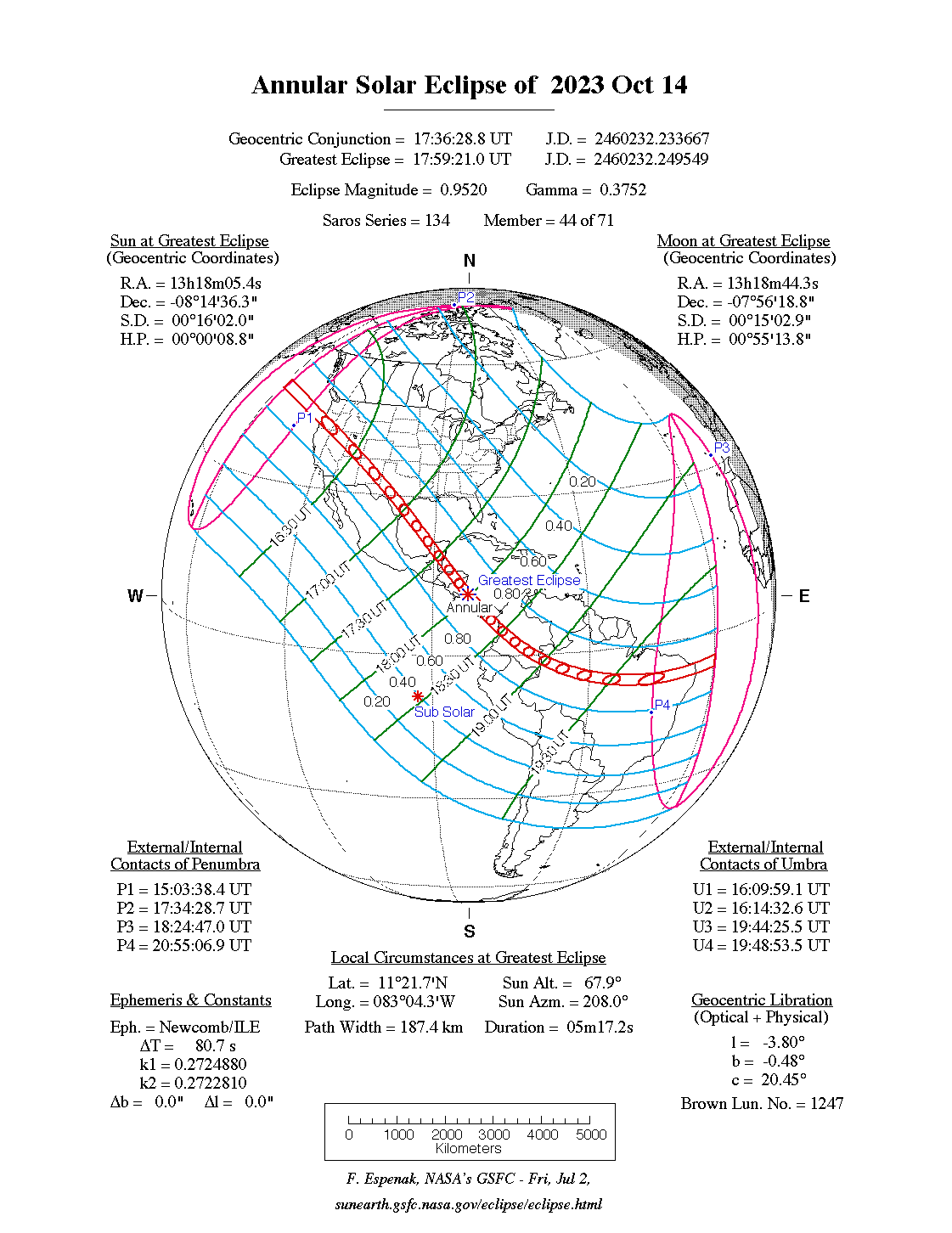An annular eclipse of the Sun occurred on Saturday 14 October, 2023 UT, lasting from 15:03–20:55 UT. The Sun was 95% covered in a moderate annular eclipse, lasting 5 minutes and 17 seconds and covering a broad path up to 187 km wide. It was visible in the USA, central America and south America. The partial eclipse was visible across most of the Americas.
The timings of the phases of the overall eclipse
worldwide are as follows. In any particular
place it would have been seen for a significantly shorter
duration as the shadow moved across the Earth:
| Partial eclipse began: |
15:03:38 UT |
| Annular eclipse began: |
16:09:51 UT |
| Maximum eclipse: |
17:59:21 UT |
| Annular eclipse ended: |
19:48:53 UT |
| Partial eclipse ended: |
20:55:07 UT |
During this eclipse the Sun was 0.534° in apparent
diameter, 0.3% larger than average. The Moon was just 4 days past apogee, making it fairly small.
At maximum eclipse it was 0.509° in
apparent diameter, which is 4.2% smaller than average; this was not
large enough to cover the Sun, which is why this
was an annular eclipse.
The statistics page has information on the ranges of the sizes of
the Sun and Moon, and the Moon data page displays detailed
information on the Moon's key dates.
The USA
The annular eclipse will make landfall in Oregon at about 16:18 UT, and then clip the north-east corner of California before crossing into Nevada, Utah, and Arizona, pssing right over Albuquerque at around 16:37 UT. It then crosses New Mexico and Texas, and reaches the Gulf at Corpus Christi at 16:58 UT.
Mexico, Central America
The annular path reaches the Yucatan north of Campeche at 17:24 UT, and then crosses Belize, passing right over Belize City at 17:34 UT. It then crosses over to Honduras, reaching land at about 17:41 UT, then Nicaragua at 17:48 UT, then pass back over the Caribbean at 17:56 UT.
The edge of the annular path just grazes the east coast of Costa Rica then passs into Panama at about 18:06 UT, with the centreline hitting the mainland at 18:10 UT. It passes just offshore of Punta Mala at 18:16 UT.
South America
The eclipse path reaches the Colombian coast starting around 18:24 UT, passes over Tulua at 18:32 UT, then crosses into Brazil at about 18:56 UT. It then crosses right over Brazil, passing Picos about 19:43 UT, then reaches the coast south of Natal at 19:46 UT. It ends just moments later in the Atlantic.
Interactive Map
This map shows the visibility of the eclipse.
The shaded area saw the annular solar eclipse; however, near the edges of
this area, the eclipse was very short. The bold line shows the centre
of the path, where the eclipse lasted longest.
Use the zoom controls to zoom in and out; hover your mouse over any
point on the centreline to see the time and
duration of the eclipse at that point. You can pan and zoom the map to
see detail for any part of the eclipse path.
The interactive map is currently not available.
Overview Map
This map sourced from NASA Goddard Space flight Center: GSFC Eclipse Web SiteGSFC Eclipse Web Site
The primary source of all the information on eclipses presented here at Hermit Eclipse. (NASA Goddard Space flight Center)
shows the visibility of the annular solar eclipse. It also shows the broader area in which a partial eclipse was seen. (Click on it for the
full-sized version.)
Eclipse Season and Saros Series
This eclipse season contains 2 eclipses:
This was the 44th eclipse in solar Saros series 134.The surrounding eclipses in this Saros series are:
This Saros series, solar Saros series 134,
is linked to lunar Saros series 127. The
nearest partner eclipses in that series are:
Eclipse Parameters
| UT Date/time (max) | 17:59:27 on 14 Oct UT |
TDT Date/time (max) | 18:00:41 on 14 Oct TDT |
| Saros Series | 134 |
Number in Series | 44 |
| Penumbral Magnitiude | |
Central Magnitiude | 0.952 |
| Gamma | 0.3753 |
Path Width (km) | 187 |
| Delta T | 1m14s |
Error | ± 0m07s (95%) |
| Penumbral Duration | |
Partial Duration | |
| Total Duration | 5m17s |
| |
| Partial Rating | major |
Total Rating | major |
| Sun Distance | 149224844 km (44.1%) |
Moon Distance | 397023 km (80.8%) |
| Sun Diameter | 0.534° |
Moon Diameter | 0.501° - 0.509° |
| Apogee | 03:42 on 10 Oct UT |
Perigee | 02:54 on 26 Oct UT |
| Contact p1 | 15:03:38 on 14 Oct UT |
Contact p2 | |
| Contact u1 | 16:09:51 on 14 Oct UT |
Contact u2 | 16:14:33 on 14 Oct UT |
| Max eclipse | 17:59:21 on 14 Oct UT |
| Contact u3 | 19:44:25 on 14 Oct UT |
Contact u4 | 19:48:53 on 14 Oct UT |
| Contact p3 | |
Contact p4 | 20:55:07 on 14 Oct UT |
Note that while all dates and times on this site (except
where noted) are in UT, which is within a second of civil time,
the dates and times shown in NASA's eclipse listingsGSFC Eclipse Web Site
The primary source of all the information on eclipses presented here at Hermit Eclipse. (NASA Goddard Space flight Center)
are in the TDT timescale.
The Sun and Moon distances are shown in km, and as a
percentage of their minimum - maximum distances; hence 0%
is the closest possible (Earth's perihelion, or the
Moon's closest possible perigee) and 100% is
the farthest (aphelion, the farthest apogee).
The statistics page has information on the ranges of sizes
of the Sun and Moon, and the Moon data page displays detailed
information on the Moon's key dates.
Data last updated: 2015-09-17 04:54:30 UTC.

